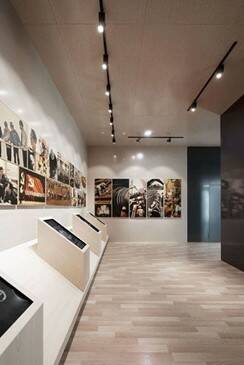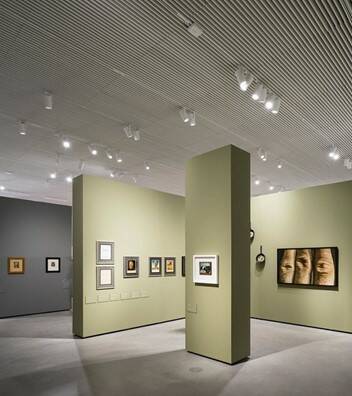- Home
- / Blog
- / Interior Design
How to Reduce Glare On Artwork
03/09/2022
What is Glare?
Glare occurs when an object appears in the field of view that is relatively small and much brighter than the surroundings and other objects.

Given that, glare impairs our visual abilities or just interferes. There are two types of glares, physiological and psychological glare.
Both types of glare need to be countered by proactive measures. Whether glare occurs in your home, in a gallery, or public venue, glare is difficult to prevent unless you understand the physics of what causes light to bounce from a surface.
Physiological Glare
Each ray of light is slightly diffused upon entering the eye. In good lighting conditions, when the observed object is well lit and its surroundings are not too dark, the proportion of this diffused light is negligible. However, if a much brighter object appears in the field of view, the proportion of diffused light inside the eye can reach such a high level that it changes the adaptive brightness of the eye. The eye adjusts to a higher brightness of the surroundings than it really is, which means that greater contrasts are also needed between the objects we want to observe and the surroundings.
If these contrasts are too small, such objects simply cannot be observed. If the obscuring light caused by the scattering of light from a glittering object exceeds 1% of the brightness of the observed object, we are talking about the disturbing effect of glare or physiological glare.
Psychological Glare
Disturbing glare can also occur if the obscurity does not exceed 1%. In this case, we can still notice other objects in the field of view, but the glittering object bothers us, as it distracts our attention from the object observation. Namely, the human visual system is naturally attracted to brighter points in the visual field, which means that performing a work task in an environment where a brighter object is present than the observed one can cause fatigue faster.
An example of this phenomenon is in a nocturnal urban environment illuminated by public lighting, there are heavily lit advertising facilities in the immediate vicinity of the road.

How Light Affects Art
Light is electromagnetic radiation that transmits energy to illuminated object through a stream of photons. Usually, most changes and damage to objects are caused by light with higher energy (ultraviolet light). Therefore, an essential step in protecting most exhibits is to reduce or eliminate the UV radiation of the light sources used.
The biggest damage is caused by the ultraviolet rays of the light radiation, which is invisible to our eyes, so there is no need to illuminate objects with it. It can be extracted from light with the help of UV protection glasses and polarizing filters.
Eliminating Harmful Rays
The most important thing is to eliminate harmful UV rays from natural light if it is present in the room. It is also necessary to use UV light filters on most lamps, as their spectrum contains a relatively large amount of UV radiation.
It is recommended to use additional glasses over the basic glass also in front of halogen and fluorescent lights if very sensitive materials are illuminated.
The reason is that less sensitive materials need more energy for changes to start happening at all. This means that for sensitive materials, filtering UV light rays alone is not enough and that we must also severely limit the light and time of exposure to light.

Art Museum’s Renwick Gallery in Washington DC by Gabriel Dawe, via Pinterest.
Read about Light's Luminescent Journey, and check out our thoughts on the Rembrandt Lighting technique used by photographers and painters world wide.
Glare Reduction Techniques
Glare occurs when lighting artwork, especially in cases where the exhibits are covered or protected with safety glass. In such cases, we need to think carefully about the angle at which visitors will observe the object and adjust to this angle the angle of incidence of light and the location of the lamps. In such a case, the use of non glare glass in display cases is also recommended, as with semi-circular or cylindrical glass, reflections are more difficult to control. In the case of uncovered exhibits, it is also necessary to pay attention to reflections, as these can occur on the very surface of the illuminated object.
The Power of Glare To Disturb and Distract
Your basic sight, your actual ability to see, can be fundamentally affected by glare. Glare can blind a person (physiological glare) and thus reduce his or her visual abilities, or it causes the person greater fatigue (psychological glare). Therefore, it is necessary to plan the lighting in such a way as to reduce glare to a minimum.
Glare is mainly caused by objects in the field of view that are close to the direction of view. Glare can be fixed or at least limited by proper lighting design. Above all, we must pay attention to the brightness of the lamps in the direction of the person.
By selecting lamps with lower brightness in the range of angles above 45 ° relative to the rectangle on the illuminating surface of the lamp, we will reduce glare. In addition, glare can be reduced by appropriately arranging the lamps according to the framed piece (so that the lamps are not located directly in front of viewers, this can be achieved with track light above the observer, directed towards the art).
Lighting Standards: An Index for Measuring Glare
Lighting standards use the glare index (UGR) as a measure of glare.
Although the UGR glare index is determined by a relatively simple equation, it is very difficult to measure. Therefore, in determining it, we rely mainly on calculations.

Direct natural light (windows and skylights) can also be a source of glare. There is a high possibility that in the morning (eastern windows) or evening (western windows) there will be direct sunlight into the room and due to the low height above the horizon the sun will cause at least psychological, and in most cases physiological glare. Therefore, it is necessary to provide appropriate blinds on the windows to reduce or eliminate unwanted glare. In addition to direct glare, reflective glare can also cause problems for observing or photographing artwork.
Reflective glare is the disturbing effect of light reflection from smooth surfaces, such as acrylic glazing pictures or other acrylic products and can bother our eye and camera lens. The reflections from clear glass are particularly annoying.
Non Reflective Glass
Light reflections can be eliminated or at least reduced by appropriate selection materials: Materials with non-reflective glass or with anti reflective coating are more suitable than acrylic materials. Reflective glare can also be reduced by appropriate placement of light sources, which affects the direction of light and thus the direction of reflected light. It also helps to choose anti reflective glass e.g., for the picture framing glass, also called Non reflective glass. While some artwork requires conservation clear glass is not the only choice as you can see.

Choosing Appropriate Lighting to Minimize Glare
Above all, when limiting glare on artwork, it is necessary to choose the appropriate lamps. Lamps with a correspondingly low brightness (below 1000 cd / m2) at critical angles (above 65 ° to normal to the illuminating surface) are suitable.
Photographers happen to have the same problem with glare as lighting designers, reading more about famous photographers can inspire us all.


